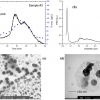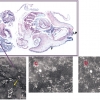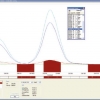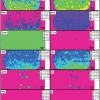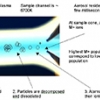Articles
Characterisation of TiO2 pigments in commercial foundation creams: a synergic use of the ICP-AES, square wave voltammetry and sedimentation FFF techniques
TiO2 is widely used as a sunscreen UV filter and as a colouring agent in all types of cosmetic products. TiO2 has recently captured the attention of the scientific community since its safety assessment has been placed again under consideration. Inductively-coupled plasma atomic emission spectrometry (ICP-AES), square wave voltammetry (SWV) and sedimentation field-flow fractionation (SdFFF) are described in this article to characterise and quantify the TiO2 particles inside six commercial foundation creams.
The use of complementary techniques in understanding the detoxification of aluminium in the freshwater snail, Lymnaea stagnalis
The authors describe the use of a range of complementary methods to explore cellular, physiological and behavioural mechanisms underlying Al accumulation and toxicity, and its eventual fate, using the pond snail as a model organism.
Using inductively-coupled plasma optical emission spectroscopy to optimise the analysis of trace elements in gasoline
This article discusses how modern inductively-coupled plasma (ICP) technology surpasses the performance of traditionally used atomic absorption spectroscopy (AAS) techniques to ensure optimal fuel quality.
Laser ablation ICP atomic emission spectrometry: a new tool for imaging of pharmaceutical tablets
Imaging of organic and inorganic constituents of tablets represents a considerable challenge and no single spectroscopic approach can provide definitive characterisation of all components and/or satisfy key measurement criteria such as sensitivity, specificity, resolution and speed of analysis. Laser ablation in combination with ICP emission spectrometry represents a powerful new tool for imaging elemental distribution in pharmaceutical tablets.
Simultaneous Raman-LIBS for the standoff analysis of explosive materials
The problem of detecting, recognising and identifying explosives at significant standoff distances has proved one of the most difficult—and most important—challenges during recent years, being today, one of the most demanding applications of spectroscopic techniques. The limited number of sophisticated available techniques potentially capable of standoff detection of minimal amounts of explosives is based on laser spectroscopy. Of the recently developed techniques, Raman spectroscopy and laser-induced breakdown spectroscopy (LIBS) are considered significant for their potential for homeland defence applications.
Arsenic speciation: a tool for assessing the environmental toxicology of arsenic using earthworms and toenails as biomarkers
This article highlights the versatility of the developed methodology for the measurement of arsenic species in a range of materials from Devon Great Consols (DGC), one of many former mining sites in the south- west of England.
Squeezing out the last drop: LA-ICP-MS analysis of liquid droplets trapped in crystals
The scientific study of fluid inclusions goes back to the middle of the 19th century. Geochemists have sought for years to find techniques that would allow them to analyse the contents of these small liquid bubbles, but the challenge is formidable. After the progressive development of techniques that yielded results for optimal samples, Laser Ablation Inductively Coupled Plasma Mass Spectrometry has at last provided a means of analysing individual fluid inclusions in typical, rather than exceptional, samples.
Dried blood spots for Pb determination using solid sampling-graphite furnace atomic absorption spectrometry
Lead exposure is an international issue. Pb may enter biological systems (as Pb2+) via food (e.g. food contaminated from cans containing Pb solders in the joints), water (e.g. use of lead pipes), air and soil (the combustions of leaded fuels have contributed to the accumulation of atmospheric and soil Pb). In the USA, the major source of ingestion in young children seems to be the dust and chips originating from old lead paint (used from 1884 to 1978).1 Foetuses and very young children (up to 36 months of age) are more sensitive than adults to relatively high blood lead levels because their brains and nervous systems are still developing and their blood-brain barrier is still incomplete. Childhood lead exposure has been correlated with school absenteeism, low class ranks, poorer vocabulary, longer reaction times and diminished hand-eye coordination, among other neurobehavioural disorders.
ICP-mass spectrometry: Let the isotopes do the talking!
Inductively coupled plasma-mass spectrometry (ICP-MS) was introduced commercially in 1983 as a very sensitive analytical technique to be deployed for (ultra)trace element analysis. Compared to the previously existing techniques of atomic absorption spectrometry (AAS) and ICP-optical emission spectrometry (ICP-OES), the main advantages offered by ICP-MS over these techniques were its pronounced multi-element capabilities and substantially higher detection power, respectively.
The analysis of used lubrication oils by inductively coupled plasma spectrometry for predictive maintenance
Analysis of used lubrication oil for metals is commonplace in many industries. The metals analysed fall into three categories: wear metals, contaminants and additive elements. The concentration of these metals and elements can then be interpreted to schedule maintenance of engines and machinery such as construction machinery and aeroplanes. The cost of unscheduled maintenance can be high, not only in materials and parts, but also in lost profits due to downtime. Once the oil has been sampled, Inductively Coupled Plasma Optical Emission Spectroscopy (ICP-OES) analysis is a very useful tool for this application.
(Image courtesy Shell Motorsport)
A comparison of two digestion methods for the analysis of heavy metals by flame atomic absorption spectroscopy
The aim of this study is to compare two of the most applied digestion methods for heavy metals determination in calcareous soils, evaluating the most effective and useful digestion method to be applied to agricultural soils devoted to growing vegetable crops in the Valencian Mediterranean region, a representative area of the European Mediterranean region.
Recent advances in in situ U-Pb dating of geological events by laser ablation inductively coupled plasma mass spectrometry
Teresa Jeffries,a Craig Storeyb and Javier Fernandez-Suarezc
aDepartment of Mineralogy, The Natural History Museum, London, SW7 5BD, UK. E-mail: [email protected]
bDepartment of Earth Sciences, The Open University, Milton Keynes, MK7 6AA, UK
cUniversidad Complutense de Madrid, Facultad de Ciencias Geológicas, s/n - 28040, Madrid, Spain
Laser-induced breakdown spectroscopy and its application to the remote characterisation of hazardous materials
An introduction to Laser-Induced Breakdown Spectroscopy (LIBS), and examples of its use for remote applications.
Trace element availability in compost
Qi Jun Songa and Gillian M. Greenwayb*
aSchool of Chemical and Material Engineering, Southern Yangtze University, China
bHull Environment Research Institute, University of Hull, UK
The ICP-ToF mass spectrometer: an alternative for elemental analysis
Erwin Hoffmanna and Christian Lüdkeb
aGOS - Gesellschaft zur Förderung angewandter Optik, Optoelektronik, Quantenelektronik und Spektroskopie eV, Rudower Chaussee 29, 12489 Berlin, Germany. E-mail: [email protected]
bISAS–Institute for Analytical Sciences, Department Berlin, Albert-Einstein-Str. 9, 12489 Berlin, Germany
Method development for ultra-trace quantification and isotope ratio measurement of uranium in urine
J. Mortona and Simon M. Nelmsb
aBiological Monitoring, Health and Safety Laboratory, Broad Lane, Sheffield, S3 7HQ, UK
bThermo Electron Corporation, Ion Path, Road Three, Winsford, Cheshire, CW7 3BX, UK
Microwave induced plasma torches for on-line combustion gas analysis
E.A.H. Timmermans and J.J.A.M. van der Mullen*
Department of Applied Physics, Eindhoven University of Technology, PO Box 513, 5600 MB Eindhoven, The Netherlands. E-mail address [email protected]
ICP-MS: determination of long-lived radionuclides
J. Sabine Becker
Central Department of Analytical Chemistry, Research Centre Jülich, D-52425 Jülich, Germany
Optimising ICP-MS for the determination of trace metals in high matrix samples
Ever since the development of inductively coupled plasma-mass spectrometry in the mid 1980s, there have been certain applications or specific analyses that have been regarded as difficult or impossible to address using the technique. This article explores the optimisation of the technique in high matrix samples.

